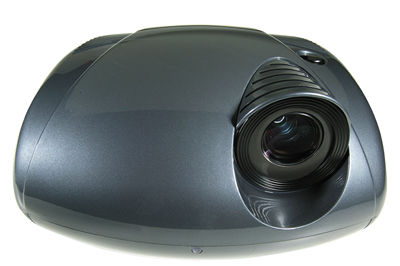SIM2 Grand Cinema HT300 Plus 16:9 DLP projector

This year, TI's latest HD2 DMD chip is spawning a whole new generation of projectors. It has the same resolution as the HD1, but it differs from the earlier chip in that each of the 921,600 individual mirrors now rotate 12° to the off position instead of the HD1's 10° tilt. This directs light from the projector's bulb farther away from the lens, allowing more of it to be absorbed; in theory, the result should be even deeper blacks.
What Else is New?
In most respects, SIM2's new Grand Cinema HT300 Plus is an evolutionary improvement over last year's HT300, the company's first true 16:9 design. Apart from the new HD2 chip, the only substantive change from the HT300 is the addition of a DVI digital input. This can be connected to any source with a DVI output, but it will not accommodate sources that have HTCP/HDMI copy protection.
Apart from these differences, the HT300 Plus has precisely the same features and physical design as the HT300, so I'll just provide a brief summary here. (For more information, see our review of the HT300 in the June 2002 issue, or online at www.guidetohometheater.com.)
The HT300 Plus has a six-segment color wheel. It provides full control of aspect ratio (including three custom settings, so you can stretch and squeeze to your heart's content). In addition, the projector accommodates all current video sources, scaling them as required to the HD2's 1280x720 native resolution—unless you select the Pixel to Pixel setting, in which case the source is passed directly to the panel. The HT300 Plus will accept composite, S-video, RGB, and component (Y-Pb-Pr) analog video sources. Standard-definition material may be either progressive or interlaced. For the latter, the projector includes Faroudja's Directional Correlational Deinterlacing (DCDi) circuitry.
Both digital keystone and mechanical lens-shift functions are available to simplify setup—which took me only a few minutes. Focus and zoom are available from the remote control. Each input has its own memory for picture controls, and there are three preset color-temperature settings (Low, Medium, High), plus a User setting accessible from the main menu. The User option provides only overall control of the red, green, and blue levels; adjustment of the low and high ends of the gray scale for all three primary colors are available in the service menu. There are several selectable gamma choices (I used Film for most of my viewing) and five built-in test patterns.
Some Nits to Pick
I have the same reservations about the HT300 Plus's physical design and ergonomics that I did about the HT300's. The fan noise was moderately low, but I could hear a high-pitched whine from the rotating color wheel in my quiet room (though rarely with a soundtrack playing). There was a small but annoying amount of light spill from the bottom of the projector. It didn't fall on the screen, but if it's in range of your peripheral vision, you might find it distracting. With the projector on a tabletop almost directly to the left of my chair, I had to prop a DVD against it to block the light. You'll want to avoid mounting the projector on or near a white ceiling.
You also have to manually switch between standard- and high-definition programming. If you don't select the correct format, you'll get an "out of range" message on the screen. The HD selections on the input menu say "32kHz"—slightly wrong for 1080i, and considerably off the mark for 720p. Not to worry; the error is in the menu's terminology, not the projector's design. Select "32kHz" and the projector will display 1080i or 720p without a hitch.
The Big Picture
I do not yet have access to a DVI source, so I evaluated the HT300 Plus through its component inputs. Unless otherwise noted, all standard-definition sources were 480i, in order to fully exercise the HT300's internal deinterlacing and scaling.
So how good was the HT300 Plus? And how much better was it than last year's HT300, with the "old" HD1 chip? Last spring, after Steven Stone turned in his review of the HT300, I spend a couple of weeks with the projector and appended my comments and measurements to his June 2002 report. The only way to definitively compare the HT300 and HT300 Plus would be to view them side by side, but the HT300 was long gone back to SIM2 by the time we received the new model. Nevertheless, I recall my reaction to that earlier projector. While they were generally favorable, I still had reservations.
That's not to say I didn't like the HT300. I did, but I was a little disappointed with its limited light output on the Stewart FireHawk screen. I seldom felt that way about the HT300 Plus. It was certainly no more of a light cannon, and, based on my measurements, it was even a bit less bright than the earlier design. But its superior contrast (both measured and visible) added just enough punch to the picture to push it over the top for me. This one improvement, coming as it does in the area where non-CRT projectors are weakest, was a definite, um, plus.























































